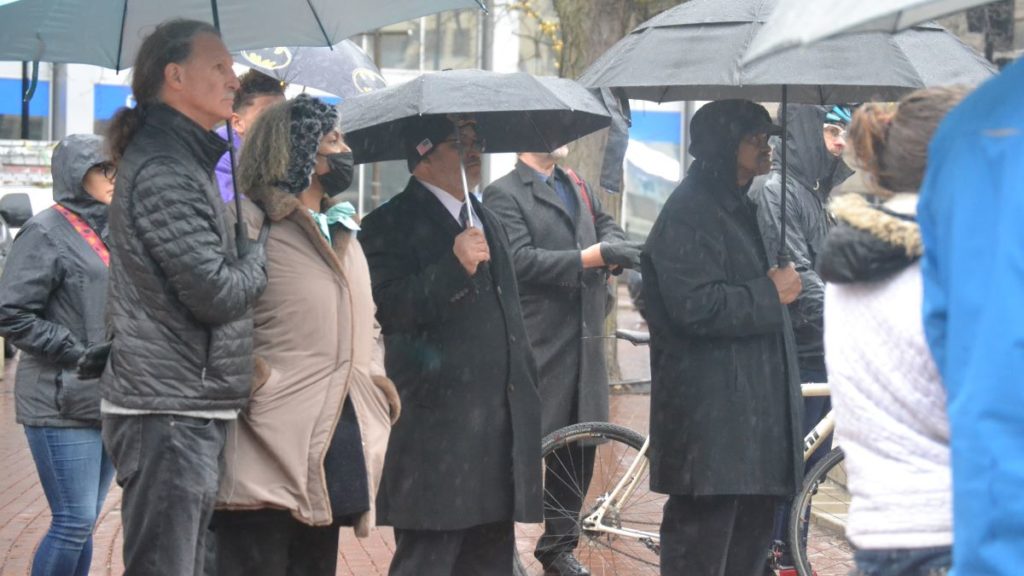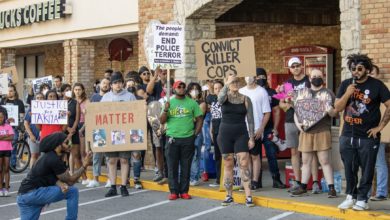On April 25, 2022, officers of the Indianapolis Metropolitan Police Department electrocuted and suffocated Herman Whitfield III, a 39-year-old Black man who was experiencing a mental health crisis. Whitfield’s parents had called 911 seeking an ambulance to bring their son to emergency care; at no point were they afraid of their child in their own home. When police arrived, instead, Gladys Whitfield asked them, “You’re not going to kill my son, are you?” They said no. They lied. Only minutes after the first officer arrived, Whitfield was unresponsive on the floor after being tased. Only after he was dead did officers call for an ambulance to come and take him away.
In a press release issued by IMPD hours after the killing, they said, Whitfield “moved quickly towards an officer,” leading one of six cops to tase him, and that he “continued to resist after the deployment of the taser.” In June 2022, IMPD released heavily-edited bodycam footage, complete with voiceover and text overlays to promote their narrative. The family immediately slammed the police video as “a selective and biased account” and called for the full video to be released. It took an order from a federal judge in November 2022 to force IMPD to release the complete footage, which was made public by the family in January. The full video completely contradicts the police narrative: Whitfield was never a danger to his parents or police, never charged at the officer who tased him and did nothing to warrant his execution. The struggle of a human being to stay alive in the face of police terrorism is not “resisting,” it is legal self-preservation.
After killing Whitfield, police continued to terrorize his family by threatening them with arrest when they asked officers to stop illegally searching their house. Police then tried to prevent them from going to the hospital where his body had been taken. When the Whitfields escaped their would-be kidnappers and arrived at the hospital, officers prevented them from seeing his body for hours before they were finally allowed to see him under police supervision. The Marion County Coroner determined that Whitfield’s death was a homicide, but no officers have been charged with a crime or even recommended to be fired for their part in his killing.

Wretched history of police murders of people experiencing crises in Indianapolis
Unfortunately, this is not the first time a situation like this has occurred in Indianapolis. In fact, IMPD has a history of using excessive force and resorting to violence. In the short timespan of 2014 to 2016, there were a total of 56 police shootings in Indianapolis, 16 of which were fatal. That number is higher than New York City, Chicago or Dallas. The total number of interactions involving mental health crises is unknown in Indianapolis, but on average, one in four people with mental disorders have histories of arrests. In addition, people with mental illnesses or mental health issues are 16 times more likely to be killed by law enforcement. Make no mistake, Indianapolis police have had many mental health calls that were grossly mishandled.
One such case was that of Christopher Goodlow, who was a 25-year-old Black man suffering a mental health crisis in December 2015. Several IMPD officers arrived at the scene, finding Goodlow holding a knife and clothed only in boxer shorts. After only a few minutes on the scene, officers proceeded to tackle, tase and finally fatally shoot Goodlow.
In April 2015, Alex Myers, a 23-year-old white man, was suffering a depressive episode and reached out to friends. Concerned for Myers’ safety, his friends called 911 and IMPD officers were dispatched to the scene. Myers was suicidal at the time and had taken a gun from the safe in his home. As with Whitfield, Myers’ mother was home with her son at the time. She wanted to try and speak with her son, but was robbed of the chance to do so. Officers placed her in a police vehicle, claiming she was not safe. Less than eight minutes after she was put in the cruiser, her son was killed. Evidence later showed that more than 35 bullets, fired by six different officers, hit their house.
Over the years, the frequency of mental health emergency calls has continued to increase. In 2017, the city launched the Mobile Crisis Assistance Team to provide emergency response for mental health crises. The program immediately came under fire from community organizers who pointed to its several drawbacks: It only operates in select areas on the city’s east side between 7:30 a.m. and 6:00 p.m., Monday through Friday, and MCAT units include an armed police officer alongside a paramedic and mental health clinician.
Prior to 2017, there was not a dedicated mental health unit in Indianapolis, but IMPD touted that its officers received limited crisis intervention training. In all of the cases mentioned above, police have refused to detail the de-escalation methods supposedly used, despite vague references like “ten minutes” of supposed de-escalation in the Whitfield home before officers became so impatient that they killed him. Rather than commit to the real work of de-escalating a situation, officers instead tick a box that they “tried” a technique or two before turning to violent means to more quickly end the situation without concern for the fact this is often deadly.
Despite the six-year existence of MCAT, this resource continues to be underutilized and underfunded. For people living outside the very limited zone MCAT responds to or who experience crises outside of their operational hours, no clinicians are on-call and police are dispatched instead to use their so-called judgment to determine who is “dangerous” and ultimately who gets to live.
The obvious inadequacy of an emergency response team that only operates during “bankers’ hours” and includes armed police was highlighted when Eleanor Northington was killed by IMPD officers in 2019. Northington, a 43-year-old Black woman, was experiencing a mental health crisis at night and went to her church for support. Instead of receiving care, an off-duty behavioral health unit police officer at the church called for more officers to come. When they arrived, they put a bag over her head and put a knee on her back, ignoring her statements that she couldn’t breathe. Northington died, according to her autopsy, of a brain injury caused by a lack of oxygen, but the report listed her manner of death as “undetermined,” blaming her weight and medical history and exonerating the police who escalated the situation and suffocated her.
None of the police officers who were responsible for Northington’s death was charged, and their names have never been released by IMPD or the City of Indianapolis.
Democrats do nothing to reduce harm — total revolution in emergency response needed
Indianapolis has been dominated politically by the Democratic Party for over a decade, which has held a majority on the City-County Council since 2011 and the mayor’s office since 2016. Since 2019, the Democrats have had a supermajority in the City-County Council with 19 of 25 seats. Supporters of the Democratic Party refer to these politicians as the “lesser” of two evils and advocate for their election as a method of “harm reduction” for oppressed communities. The reality for people experiencing mental illness in Indianapolis proves this to be a lie.
While arrests of people in crisis have been reduced, the creation of MCAT has not stopped the police from killing people experiencing mental health crises. And despite the longstanding criticism of the program’s limited hours and service area, Indy Democrats did nothing to expand the program or remove armed police from the team until cops killed Whitfield.
Months after Northington’s death, Democrats proposed a 24-hour mental health emergency response team and allocated just $2 million for it in the city’s budget. IMPD, on the other hand, was budgeted to receive $313 million from the city — more than 150 times what was proposed for the mental health team and 22% of the total city budget. As of late March, nothing tangible has been accomplished to make this 24-hour emergency response team a reality.
To meaningfully address the cascading mental health crises created by our society, a shift away from impatient, deadly police is desperately needed. Alternatives are not just theoretical, but already exist in practice in cities across the country and can be replicated and built upon. Rather than have armed police respond to crises and resolve them quickly no matter the cost to human life, participatory public safety teams rooted in the community must be empowered to answer calls for help and take as long as needed to actually de-escalate situations to preserve the lives of our neighbors and coworkers. To truly address mental health, we must restructure society to eliminate the root causes of mental illnesses like depression and anxiety. By ensuring people’s basic needs are met, that unemployment is ended while providing for abundant free time, and alienation from our communities is replaced with community involvement and connection, we can eliminate many of the issues that drive the soaring rates of mental illness under capitalism.
Feature photo: Protesters demand justice for Whitfield and others killed by police at a Jan. 6 MLK Day rally and march in Indianapolis. Liberation photo






